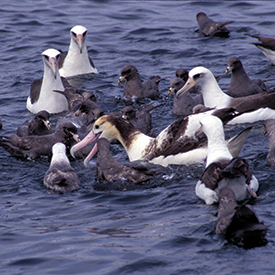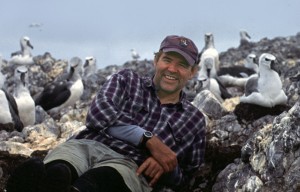How Fishing at Night Can Help Save West Coast Albatross
 Longline fishing, in which long lines with baited hooks are attached at intervals behind a boat, is a common technique used to catch many high-value species including halibut, tuna and sablefish. However, those fish are sometimes caught along with unintended targets — known as bycatch — including about 160,000 seabirds a year globally. Along the West Coast some of the accidentally-caught birds are endangered species, such as the short-tailed albatross.
Longline fishing, in which long lines with baited hooks are attached at intervals behind a boat, is a common technique used to catch many high-value species including halibut, tuna and sablefish. However, those fish are sometimes caught along with unintended targets — known as bycatch — including about 160,000 seabirds a year globally. Along the West Coast some of the accidentally-caught birds are endangered species, such as the short-tailed albatross.
Continuing research that earned a 2015 Presidential Migratory Bird Federal Stewardship Award, Washington Sea Grant scientist Ed Melvin and partners at Oregon Sea Grant, Oregon State University and NOAA Fisheries published a new paper in the December 2017 issue of the journal, Fisheries Research. The paper builds upon past work and suggests a new option for consideration by fishery managers to reduce short-tailed albatross bycatch: encouraging fishermen to set their lines at night.
Melvin’s work to reduce seabird bycatch from longlines began in 1999 in Alaska, which is home to the country’s biggest fisheries. He worked with fishermen to test and fine-tune streamer lines, a type of seabird avoidance technology that is towed above the water behind the fishing vessel, creating a visual barrier that keeps seabirds away from the baited hooks below. In Alaska, this technique has resulted in reducing seabird bycatch by 90 percent. Melvin and his colleagues embarked on the recently published study with the intention of finding out whether the same held true for longline fisheries down the rest of the West Coast.
 It did and it didn’t. For West Coast vessels that use fishing gear similar to that used in Alaska, streamer lines were effective. But the researchers discovered that some boats in the West Coast sablefish fleet use floats to keep their bait off the seafloor — a technique that renders streamer lines less effective because the bait sinks slower and further away from the vessel. “Encountering this unique gear led us in an unplanned direction,” Melvin says.
It did and it didn’t. For West Coast vessels that use fishing gear similar to that used in Alaska, streamer lines were effective. But the researchers discovered that some boats in the West Coast sablefish fleet use floats to keep their bait off the seafloor — a technique that renders streamer lines less effective because the bait sinks slower and further away from the vessel. “Encountering this unique gear led us in an unplanned direction,” Melvin says.
Through workshops held in ports throughout the region, the researchers learned that some fishermen set their lines at night, when birds are generally less active, as a way to avoid seabird bycatch. “The fishermen invited us onto their boats and provided us with a lot of insights,” says Amanda Gladics, a coastal fisheries specialist with Oregon State Sea Grant who co-authored the Fisheries Research paper.
The researchers quantified the fishermen’s anecdotal findings by sifting through 12 years of data collected by the NOAA Fisheries West Coast Groundfish Observer Program. “Not only did we find that night fishing reduced seabird bycatch — it did so dramatically,” Melvin says. Night fishing reduced albatross bycatch by 30 times compared with setting lines during the day. What’s more, it increased the target catch by 50 percent, meaning that fishermen would have to spend less time with their hooks in the water to take home the same amount of catch.
 This isn’t to say that night fishing is a great fit for every fishery. “Alaska’s high latitude fisheries for sablefish and halibut peak in the late spring to early fall, so there’s not a lot of night to work with,” Melvin says. Plus, he and his colleagues found that night fishing in Alaska increases the bycatch rate of northern fulmars, which are less common farther south. “A single ‘one size fits all’ solution won’t work for all fishermen and all boats, so developing multiple seabird avoidance options that are specific to the region is crucial,” Gladics says.
This isn’t to say that night fishing is a great fit for every fishery. “Alaska’s high latitude fisheries for sablefish and halibut peak in the late spring to early fall, so there’s not a lot of night to work with,” Melvin says. Plus, he and his colleagues found that night fishing in Alaska increases the bycatch rate of northern fulmars, which are less common farther south. “A single ‘one size fits all’ solution won’t work for all fishermen and all boats, so developing multiple seabird avoidance options that are specific to the region is crucial,” Gladics says.
Seabird bycatch has obvious environmental implications. Gladics points out that it has economic ones, too. “Losing bait to birds can be costly, and serious economic harm can occur if excessive seabird bycatch triggers a fishery closure,” she says.
The researchers’ work could frame future policy development. For example, the U.S. Fish and Wildlife Service incorporated these finding into a Biological Opinion that will soon trigger new federal regulations to protect the endangered short-tailed albatross in West Coast longline fisheries
“We’re delivering the science to the loading dock of policymakers, and they decide how to use it,” Melvin says.